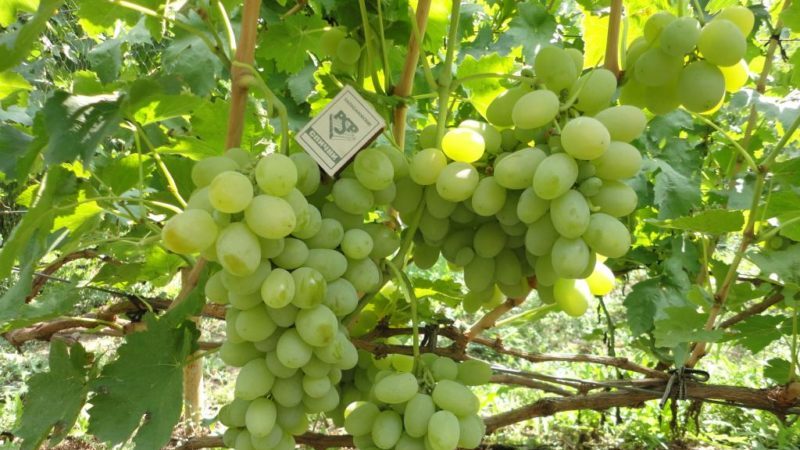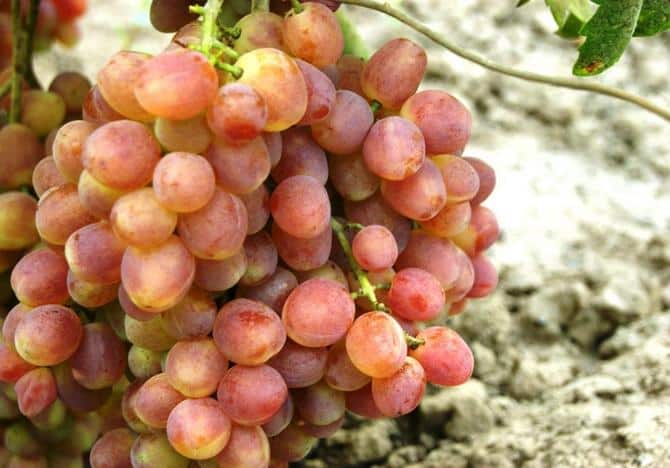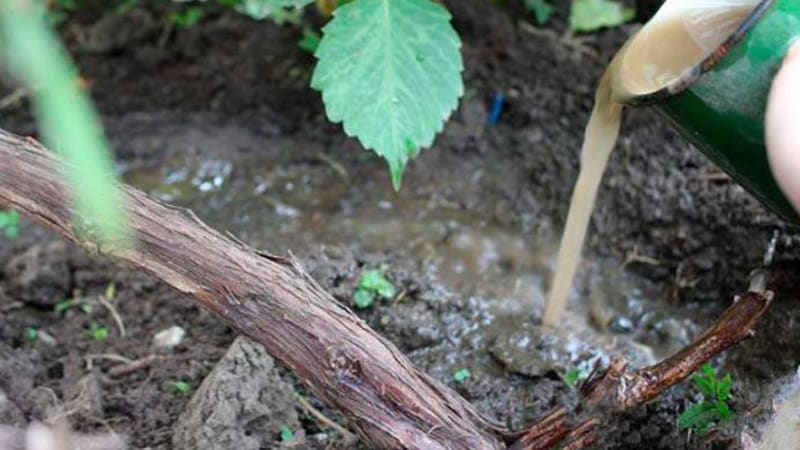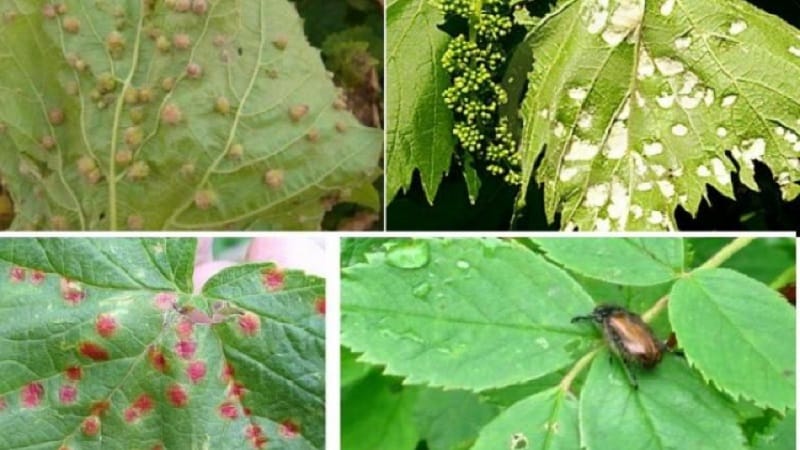Hybrid grape Kesha - description and characteristics
Kesha is a famous grape hybrid, the result of the work of Russian breeders. Gardeners fell in love with Kesha for its large clusters and berries, sweet and pleasant taste, and stable yield. The grape turned out to be so successful that agronomists developed hybrids and varieties derived from it - Keshu 1, Keshu 2, Luchezarny and Krasny. Let's look at how they differ from each other and what to pay attention to when planting and growing these crops.
Kesha grapes - variety description

The grapes are early ripening, the ripening period varies from 115 to 130 days, the duration depends on the region growing. The bushes are tall, reaching a height of 6 m. The leaves are medium sized, light green. The clusters are conical in shape and grow on a long stem. The weight of one bunch is 700-900 g.
The berries are large, transparent green, round in shape. The weight of the berry is about 10 g. Thanks to the thick peel, Kesha is suitable for transportation over long distances. The pulp is sweet and tender, taste sweet with a rich fruity aroma.
Bears fruit 3-5 years after landings. The variety is self-fertile - pollinating insects or other grape varieties are not needed for the ovary. All berries are pressed tightly against each other, do not crumble or crack. The fresh harvest is stored in the refrigerator - the bunches do not lose their marketability and taste.
Attention! Kesha grapes are grown in the southern and northern regions, as well as in central Russia. It is frost-resistant, which is important for areas with long, cold winters and short summers.With proper care and timely feeding, Kesha is resistant to common crop diseases.
Derived hybrids and their characteristics
The name Kesha is common among agronomists and gardeners. There are hybrids Kesha 1, Kesha 2, Kesha radiant, Kesha red. Each of them has its own advantages and disadvantages.
Kesha 1

Kesha 1 is a mid-late hybrid for cultivation in the northern regions of Russia. The bushes are powerful and medium-sized, the shoots grow straight. The leaves are large and slightly pubescent. The ripening period varies from 130 to 140 days. The weight of the bunch reaches 1 g, the weight of the berry is about 12 g, individual specimens grow weighing up to 16 g. The shape is elliptical, the light green peel has a strong waxy coating. The skin is not as dense as Kesha’s, but this does not prevent the bunches from being transported over long distances. The taste is medium sweet, pleasant, with a nutmeg aroma. The pulp is of a delicate consistency, there are few seeds.
Interesting! The Kesha 1 grape has another name - Talisman. Among the advantages of the hybrid, gardeners note the large size of the bunches, the commercial quality of the berries, frost resistance, and the plant’s immunity to mildew.
Kesha 2
The early-ripening hybrid is famous for its unpretentiousness - gardeners harvest 100-115 days from the moment the buds open. Medium-sized bushes, strong vine. The leaf blades are large, rich green in color. The weight of the bunch is from 1.5 to 2 kg, the weight of one berry is about 12-15 g. The color is transparent green, the flesh is fleshy, the peel is dense.
Due to the large number of seeds, it is suitable only for industrial cultivation. The dessert taste is moderately sweet with a nutmeg aftertaste. Kesha 2 is suitable for transportation and sale and is resistant to fungal diseases.
Description of Kesha Red grapes

Kesha Red is a mid-season hybrid, ripens in 120-130 days. The bush is tall and dense, requiring a lot of free space for landings. The clusters are conical-oval in shape, weighing from 1.2 to 2 kg. The berries are elastic and large, the weight of one varies from 12 to 17 g.
The color is green-red, the peel is dense, there is a waxy coating. The taste is sweet, the flesh is juicy, dense, aromatic. Red Kesha is rarely damaged by insects; after ripening, the berries do not fall off and are suitable for transportation.
Attention! Grapes are distinguished by their vigorous growth, so gardeners tie them to wooden stakes to provide support. The clusters are also regularly thinned out so that the bush does not become overloaded and the berries grow large and sweet.
White Radiant

The hybrid is drought- and frost-resistant, easy to care for, and suitable for planting in the Urals and the Far Eastern region. The ripening period is 125-130 days. The clusters are large, cylindrical in shape. Berry weight 15-20 g, round shape, beige-pink color, there is a slight waxy coating. The skin is medium thick, the flesh is fleshy. The taste is harmonious and sweet. White Radiant is universal in use, distinguished by commercial qualities and transportability. Withstands temperatures down to -27°C.
White Radiant is undemanding to the soil, but shows the best yield on moist and well-warmed soil. The grapes are resistant to wasps and mildew, and are rarely affected by gray rot. White Radiant is suitable for industrial and personal cultivation.
Features of cultivation
Kesha grapes consistently bear fruit if planting and care rules are followed. The plant needs regular watering and fertilizing. The choice of landing site also plays a role.
Necessary conditions for growth
For Kesha, spacious and sunny areas are chosen. They must be protected from winds, especially when it comes to northern regions. It is recommended to plant grapes so that there is a fence, hedge or house on the north side of it. A day before planting, the seedling is soaked in water so that the roots are saturated with moisture and quickly adapt to the climatic conditions of the region. When choosing a seedling, pay attention to its appearance - spots, cracks, breaks and other defects are unacceptable.
Attention! It is recommended to plant Kesha in early spring, having prepared the holes in advance. At the end of autumn, the site is dug up and a layer of peat and ash is added. A drainage layer of 15-20 cm made of pebbles or broken bricks will not be superfluous. A seedling is placed in the prepared hole, a support is installed nearby - it is necessary for the grapes in the first years of life.
Plant the grapes deeply so that no more than two buds remain on the surface. The kesha is watered generously with clean water at room temperature, after which the plant is thoroughly mulched. For planting, choose a dry and windless day.
Rules of care

Caring for grapes does not require special knowledge. The main thing is to carry out all procedures on time, to avoid waterlogging or drying out of the soil, and to monitor the amount of fertilizer applied:
- The grapes are watered abundantly while the berries are growing, and from the end of July watering is stopped. Overwatering leads to the formation of root rot, the plant stops growing and developing. Young plants spend 10 liters of water, adults 12-14 liters. The frequency of watering depends on weather conditions - if there is frequent rain, they are reduced.
- At least twice a season, grapes are fed with ash, humus, ammonium sulfate, and ammonium nitrate.Mineral fertilizers are applied before and after flowering, organic fertilizers are applied before fruit ripening. Foliar feeding is carried out 2-3 times per season - they ensure the smooth ripening of fruits and protect Kesha from diseases and insects.
- Throughout the season, plantings are mulched and loosened. The procedures provide oxygen access to the roots, strengthen the immunity of the grapes, and prevent the appearance of pests.
Gardeners pay special attention to pruning grapes. During the period of bud break, cut off the barren shoots growing at the base. All weak and dry branches are also broken off - they are unsuitable for the formation of new fruits. At the end of June, fruit shoots are pinched - this provides nutrition to the bunches. At this time, the berries gain weight and taste. When the vine becomes longer than 3 m, it is pinched. They also do not forget about stepsoning; from June to August, all mustaches are cut out.
Diseases and pests

Due to an overabundance of mineral supplements and hot weather, Kesha may develop anthracnose. The fungal disease affects all parts of the plant; brown and brown spots are visible on the leaves. After a week, they spread not only to shoots and leaves, but also to fruits. For preventive purposes, gardeners use dusting with sulfur and spraying with a solution of copper sulfate. To treat anthracnose, the drugs “Switch” or “Teldor” are used.
Among the pests on the site there are moths, cushion flies, flies, slugs, and weevils. Some insects feed on leaves, others on grape juice. For prevention, it is recommended to follow planting recommendations - soak the seedling in a solution of potassium permanganate, add fertilizer to the soil, and clean the soil of weeds.They get rid of insects using folk and professional means - spray the bushes with an ash solution, Nitrafen or Confidor.
Conclusion
Hybrid Kesh and its varieties are versatile and frost-resistant grapes. It is planted in the Moscow region and Siberia, in the Urals and in central Russia. Kesha 1 and Kesha 2 are distinguished by light green fruits and a pleasant taste, Kesha Red - by reddish berries with a nutmeg aroma and aftertaste. Caring for Kesha consists of watering and fertilizing, pruning and loosening. The berries have a dense peel, so the crop is suitable for transportation and storage. The fruits are eaten fresh and also used for processing - jams, juices, jams, and marshmallows are prepared.